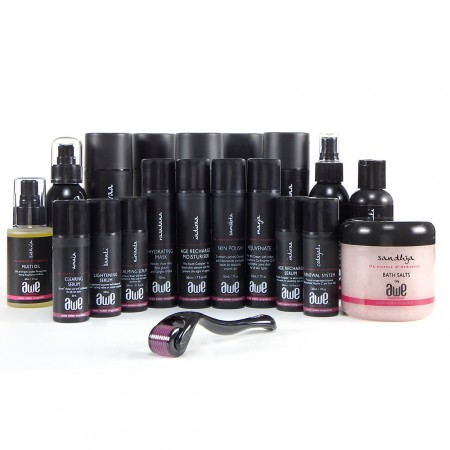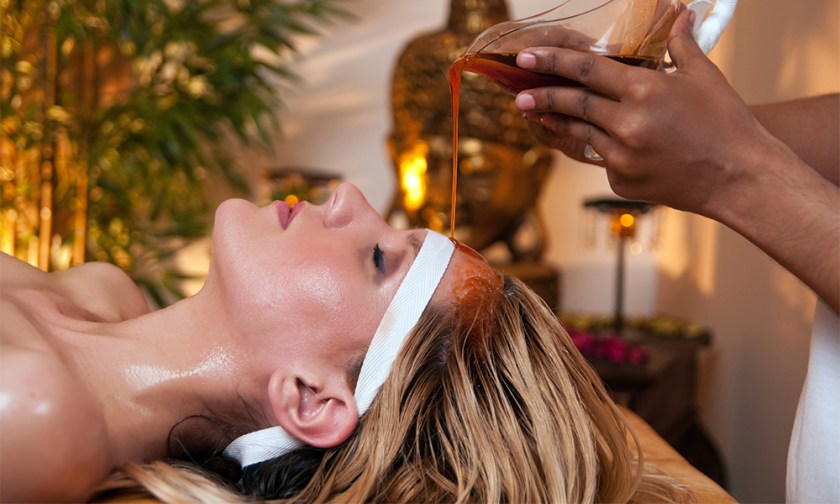India’s traditional form of healing, Ayurveda – some 5,500 years old – is fast gaining popularity among Westerners, like yoga before it.
We can thank the likes of celebrated wellness guru Deepak Chopra, Oprah and Hollywood hipstars (sic) for shining the broader light on the modality, but the truth is Australians have always been pretty keen to embrace the “out there” before it becomes a recognised “trend”.
This editor became aware of Ayurvedic medicine nearly 20 years ago through a longtime natural therapist, who was then in a business partnership with an Ayurvedic swami; an Australian GP who had retrained in the ancient healing system.
No names, no pack drill, but he complemented extraordinary Western medical treatments and care with Ayurvedic healing and said actor is alive and kicking nearly 20 years later.
But I digress. Ayurveda, or Ayurveda-inspired aesthetics and wellness treatments are spawning a new avenue of potential for contemporary aesthetics, wellness and cosmetic medical practitioners.
It’s user-friendly and is for everyone, and it’s very likely you’re already intuitively practising some of it.
SPA+CLINIC will be exploring more in coming stories, but for the purposes of this story we’re focusing on skincare, courtesy Rebecca Powne*, creator of Australia’s AWE Cosmeceuticals:
We do not claim to be a traditional Ayurvedic brand. We are inspired by ancient Indian medicine.
AWE is all about encompassing the natural philosophies of Ayurveda and combining them with modern scientific findings, delivering high quality skincare designed to achieve visible results, with a natural ethos.
I think we differ from other Ayurvedic skincare brands in that we are focused on cosmeceutical ingredients and active delivery systems.
Our ingredients are sourced both locally and globally. Of greatest importance is the high quality raw materials we source and sustainable natural ingredients.
Over the past 10 years, I have noticed people becoming much more aware of Ayurveda.
There have always been many Ayurvedic ingredients used in skincare, however they were not attributed to Ayurveda; for example: licorice, gotu kola, aloe vera, honey, coconut oil, boswellia serrata (Indian frankincense).
I believe Ayurveda is gaining popularity in Australia as a modality, mainly due to much more being written about it, interest in ancient traditions such as oil pulling, and a desire for people to lead a more natural and healthy lifestyle.
Ayurveda is very much about the person as a whole, therefore there is a great deal of information on daily and seasonal rituals that help maintain the body’s equilibrium.
 THE ALL-IMPORTANT DOSHAS
THE ALL-IMPORTANT DOSHAS
Ayurveda holds an elemental view of the universe and believes people are made up of various combinations of these elements.
The five elements are Air, Ether, Fire, Earth and Water. They form the three biological humours of Ayurveda called doshas: Vata, Pitta and Kapha.
Vata is composed of air and ether
Pitta is composed of fire
Kapha is composed of earth and water
The dominance of a particular dosha determines certain physical, mental and emotional characteristics, and importantly may predetermine potential health risks.
All three doshas are present in every cell of the body. However, each dosha has an area of dominance, which is their site of origin:
Vata primarily resides in the colon; characterised by qualities such as light (weight), dry, rough, moving, subtle. [Vata types] are tall and thin or petite, have dry skin and nails, are generally thin and break easily, are adaptable. When unbalanced, Vatas can be anxious, worried, talk very fast, tire easily, very thin, dry skin, gas, constipation, bone problems or arthritis.
Vata types need to keep warm, eat nourishing food and maintain a stress-free environment. They will feel the cold and therefore love a hot bath! Just be careful it is not too hot or this will be detrimental to Vata’s already dry and thin skin. Use essential oils with sweet aromas such as rose, yang slang and lavender.
Pitta resides in the small intestine: slightly oily, hot, light, odorous, liquid. Warm, clear, penetrating thoughts, passionate, intelligent, athletic, moderate, muscular build. When unbalanced, Pittas can be hot-tempered, impatient, too critical. Physically they may develop health issues such as ulcers, infections, rashes, acne, eye problems or high blood pressure.
Pittas need cooling. They will generally be the person who feels warm, so need to listen to this and avoid causing increase in temperature; have a cool/warm shower and apply a calming lotion for a sensitive skin type.
Kapha resides in the stomach: oily, cold, heavy, slow, smooth, slimy, and static. Characteristics are being loyal, calm, big-boned, with a strong, deep, clear voice. When unnbalanced: Lethargic, sentimental, too attached, overweight, water retention, bronchitis.
SKINCARE TIPS
In Ayurveda, like exacerbates like. Therefore:
Vata dominance types will need a heavy, warm diet, maintain practice of gentle exercise and ensure they use oils and unctuous products due to the dry nature of their skin. Because Vata skin is typically dry and thin, any skincare cosmeceuticals used should have a focus on moisture and making the skin plumper.
Look out for: Coconut oil, almond oil, papaya leaf extract, and saffron extract as these will all contribute towards creating a harmonious Vata balance for skin. Vata types should also invest in anti-ageing actives, as skin ageing can occur earlier with this skin type.
Pitta dominance is comprised of fire and needs cooling. These skins tend to flare up, both mentally and physically. They require cooling elements. Their diet should be based on raw and cold foods and avoiding spicy food.
Compatible ingredients in cosmeceutical skincare products to look out for include aloe vera, gotu kola, sunflower oil, turmeric, sandalwood and lavender.
Kapha dominance requires less fat in the diet, lighter food options and more vigorous exercise. Kapha is prone to oiliness and congestion and so should place a greater emphasis on cleansing and exfoliation than on moisturising, as skin is likely to have excessive oil already.
Kapha feels the cold and will like the heat of a shower, however, not too hot! Due to the oilier nature of their skin type a lighter oil, such as coconut Oil is recommended for kapha. Body brushing is also very beneficial for the more sluggish nature of kapha.
Ingredients to keep an eye out for include turmeric, alamaki (Indian gooseberry) and red sandalwood.
BASIC PRINCIPLES OF AYURVEDA
By Chara Caruthers*
Ayurveda Wants You To Stop Comparing Yourself To Others
You are 100 percent unique in every way. Ayurveda knows this and believes that your approach to living, growing and healing should reflect this too. Diets, medicines, and careers that work for others may not work for you. Life choices that work for you may not work for others. Accept this.
Key message: Know yourself and love yourself … a lot!
Ayurveda Believes That You Are Inherently Healthy
Healthy, according to Ayurveda, is your natural state. It’s you and your environment in balance. Unhealthy (eg. anxiety, obesity, constipation, depression, etc.) is you and your environment out of balance. The good news is imbalance doesn’t usually happen overnight. So if you can recognise it, you can stop it … or slow it down.
Key Message: Know that you are capable of achieving balance. Pay attention to the signs that the balance is shifting then do something about it.
Ayurveda Understands Why You Do What You Do And Wants You To Understand Too
Another principle of Ayurveda is that we are made of the same stuff and governed by the same laws as nature. Ayurveda recognises five elements: Space, Air, Fire, Water and Earth.
How those elements behave and interact is significant. For example, the fire in you looks like digestion, inflammation, ambition, anger. The earth looks like cell walls, bones, stubbornness and loyalty. All the elements are at work inside us but our body type, personality, and behaviours are usually governed by just one or two (eg “she has an airy personality”, “he’s a hothead”, “she’s built like a rock”).
Key Message: Understanding how the elements work in you and how to make the most of your elemental strengths and weaknesses is the key to a blissful life!
Ayurveda Knows That Cleaning Up Your Act Is One Of The Keys To Getting What You Want
As human beings our capacity for bliss is limited only by our willingness to “empty our cup” again and again. Clearing away the old to make room for the new is an ancient idea that works! And cleansing (five ways to Sunday) is a key part of the Ayurvedic approach to extraordinary living.
Key Message: Physical, mental and emotional detox rocks! Do it regularly.
Ayurveda Embraces The Whole You
You are more than just a brilliant mind and a pretty face. The essence of you is what’s capable of lighting up the world AND figuring out what to have for dinner. Ayurveda recognizes your spirit as a driving force in the process of healing and keeping you in great shape. It acknowledges the connection between the mind, body and soul and uses each to balance the other.
Key Message: You are WAY more capable of healing and happiness than you’ve been led to believe.
“So there you are, a peek inside the world of Ayurveda,” says Chara. “And if you haven’t guessed by now the point of all of this, really, is to help you understand that Ayurveda isn’t a special diet, or herbal medicine or a whacky mysterious fad from India. The very heart of Ayurveda is YOU, feeling amazing, looking radiant, choosing powerfully, connecting passionately with the world and being authentically YOU.
“The beauty is you don’t have to know much for it to change your life. So if you’ve never heard of it before or perhaps you’re wondering what, if anything, Ayurveda has to offer you, here’s my “cut to the chase” version of why you might want to give Ayurveda a first (or second) look!”
* Chara Caruthers is a passionate yoga therapist, Ayurvedic practitioner and educator who lives in Byron Bay, NSW, and is “dedicated to sharing the wisdom of Ayurveda in a way that’s powerful, practical, accessible and fun!”.




